If there's one job in a chemical processing plant (or any manufacturing plant for that matter) that gets short shrift, it's maintenance, according to Thomas L. Dabbs, Plant Performance Services at ITT. Dabbs led a course called Pumps — Lowering Total Cost of Ownership and Optimizing Efficiency at the 2011 Chem Show as part of AIChE's offerings of tutorials, workshops and educational sessions.
[sidebar id="1"]While the title refers to pumps, Dabbs assured attendees that what they were about to learn could apply to any piece of equipment in the plant. And he also noted that they would soon be equipped with information that would prove effective at getting management on board with making worthwhile changes and additions to the maintenance roster.
To be sure, Dabbs says that most manufacturing facilities don't know how much maintenance labor they need. He offered several benchmarks to be aware of when trying to assess what's really going on in a facility. He also cautioned against applying the benchmarks verbatim, since every plant is different and some benchmarks may not make sense.
[pullquote]The first important benchmark is OEE (Overall Equipment Effectiveness), which should be roughly 85%. Another benchmark to be aware of is backlog (ready), which should be about 2 to 4 weeks; and backlog (total), which should be between 4 and 6 weeks. "You can get in trouble if you don't know your backlog numbers," says Dabbs.
Dabbs also suggests that unscheduled equipment downtime be less than 5%, unscheduled maintenance hours should be around 10% and total maintenance costs should hover around 2% to 4% of asset value.
"To determine how much labor you need in maintenance, take each piece of equipment and develop a maintenance strategy," explains Dabbs. "Establish how many hours the strategy will take and add each up – divide that number by 40 (for hours worked per week)." For a more realistic view, he suggests dividing that number by 28, since it's rare to get a full 40 hours of dedicated work.
To drive the point home, Dabbs had attendees work out all the numbers for a fictitious company – Beleau Par Chemicals (read Below Par). While the name is fake, the information provided via the case study is from an actual client that Dabbs worked with. The five-page case study revealed several details about the operations including total maintenance costs; indirect labor costs; MRO inventory value, usage and carrying costs; production costs; quality rates and various KPIs. The exercise is geared toward helping attendees take what they've learned from Dabbs and apply it to their own facility.
Dabbs has taught this course several times, and even offers a one-day workshop to facilities and will do the workshops on location.
Knowing the workings of your facility is paramount in effectiveness. After all, Dabbs says, "In God we trust, the rest of us bring data."
You can contact Thomas Dabbs via e-mail: [email protected] or you can call him at 843-599-1771.
Traci Purdum is senior digital editor for Chemical Processing. She is currently trying to calculate her backlog workload to prove to her publisher she's a worthwhile employee. You can e-mail her at [email protected].

